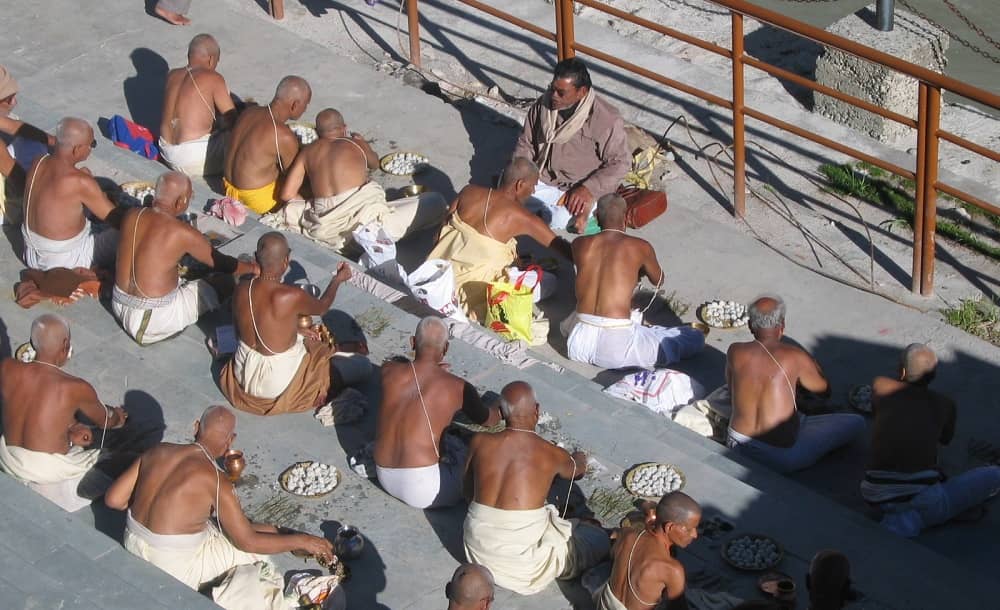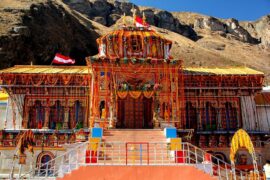Badrinath Dham: Badrinath Temple & Yatra Information
Badrinath Dham is located in the Chamoli district in Uttarakhand, Badrinath is surrounded by beautiful mountains and snow-capped mountains. The holy temple of Lord Vishnu at a height of 3,133 meters is among the four most important “Char Dham” pilgrimage sites in India. (The other Char Dham sites are Dwarka, Puri, and Rameswaram.)
Situated between the Nar and Narayan mountains, the pious land of the god Vishnu also belongs to the Chota Char Dham Yatra in Uttarakhand. Starting from Yamunotri at one end till Badrinath at the other, it is a religious tour of the picturesque Garhwal Himalayas.
It comes as no surprise that Badrinath is called “Dwarbhanga Sthan” as it’s revered by both Vaishnavites as well as Saivites, who have come together to make it one of their Char Dham pilgrimage sites.
Badrinath Dham is easily accessible by motorable roads; its location makes Badrinath extremely accessible and straightforward. Around 3 km from Badrinath is the village, called Mana, which is one of the last villages before the boundary of India ends and that of Tibet begins. The peak of Neelkanth stands strong spreading its mighty aura for all pilgrims and travelers alike.
Badrinath Weather
The average maximum temperature usually reaches about 18° Celsius with the average minimum being 8° Celsius. Because of this, it’s necessary to pack warm and woolen clothes if you’re planning on staying in Badrinath for an extended period of time. It’s also important to note that snowfall is common during winter, so be prepared for that as well! The temperature during winter can drop as low as 5° Celsius, so it’s no surprise that this is typically a tourist-free season due to the extreme weather conditions.
Suggested Read – Vashudhara Fall Near Mana Village at Badrinath Temple

Legends, Myths & Significance
Badrinath Temple is renowned as one of the greatest temples in Uttarkhand, India because it’s legendary in numerous stories and its significance in Hinduism. According to one mythological story, Badrinath Temple was where Lord Vishnu underwent rigorous austerities during his meditation.
He was unaware of the scorching heat and the tremendous rainstorm around him, that is until the beautiful Goddess Lakshmi took on the form of a Badri tree and draped it over his body for shelter. This act inspired Vishnu so much that he named the spot Laskhmipuram after her.
Shiva and Parvati
Another legend tells that the Badrinath Temple in Uttarakhand was dedicated to Lord Shiva and Goddess Parvati, who had once decided to perform Tapasya (meditation) in Badrinath. One day, while they were meditating, they were interrupted by a crying child who asked them why he couldn’t also meditate there. When Shauri (the disguised form of Lord Vishnu) told him that he should go to Kedarnath if he wanted to meditate somewhere else, Shiva and Parvati abandoned their plans and moved to Kedarnath after realizing his identity.
Nar & Narayana
Badrinath Dham Religious place in Uttarakhand is also related to the tale of the two sons of Dharma, Nar, and Narayana who wished to set up their hermitage and expand their religious base amidst the pious Himalayas.
Going by legend, during their quest to find a suitable place for their hermitage they led to a chanced discovery of the four sites of Panch Badri on the banks of Alaknanda River namely Dhyan Badri, Yog Badri, Bridha Badri, and Bhavishya Badri. Finally, they came across a spot that was blessed with two fascinating cold and hot springs behind the river and named it Badri Vishal, this is how Badrinath came into being.
Suggested Read – Kedarnath to Badrinath Enroute Attractions

Pandava & Swargrohini
It is said that in the holy epic of Mahabharata, the Pandavas traveled via Swargarohini, also known as the ascent to heaven. This term comes from Mana town, north of Badrinath, which holds special significance for Hindu mythology fans.
The Pandavas are also said to have climbed via the Swargarohini, a popular way ‘up’ to heaven, while on their route towards home. From Mana, they traveled back south through Parvati Valley and were passing by the temple town of Badrinath where they decided to stop at the temple.
Visiting Places in Badrinath
Taptkund
Down below the temple grounds near the spring, there is a naturally occurring hot water source. Bathing in these waters before visiting the sacred shrine of Badrinath is believed to ease one’s journey through life on earth by blessing them with ultimate peace, love, and energy. Also nearby are five boulders respectively known as Narad, Narsingh, Varah, Garur, and Markanday who are integral parts of Hindu mythology.
Suggested Read- Neelkanth Trek – a complete Trekkers Guide

Brahma Kapal
The puja, held by the banks of the Alaknanda River at a little more than 100 meters from the Badrinath Temple, is performed to free those who have incurred bad karma in their previous lives.
Neelkanth Peak
Known as the ‘Queen of Garhwal’, Neelkanth Peak is located in the state of Uttarakhand and stands at a colossal height of 6,597 meters (approx). Named after Lord Shiva, the brilliance of this peak gets more intensified as it catches all its glory when the first rays of light shine upon it at dawn.
Mata Murti Mandir
Located 3 km from the Badrinath Temple of India, it is located on the banks of the Alaknanda River. This temple is believed to be the mother of Lord Nara and Narayan, twin-avatar incarnations of Lord Vishnu. As it is believed, Mata Murti (the Mother) was pleased with their prayers for nine months and eventually tempted Him to come out in his divine form from her body and save all devotees. Every year, people throng here during September to attend the ‘Mata Murti ka Mela’ (fair).
Charnapaduka
The Charanpaduka Mountain is strewn with rocks, as this is the route from Badrinath town to Charanpaduka. The steep climb up takes about 3 kilometers of rough terrain, but it is well worth the effort for those who wish to see a face of the earth that may have never been seen by many.
Sheshnetra
Located a kilometer away from the temple of Badrinath, there is a rock formation that resembles Sheshnag, an important Indian mythological snake believed to have been guarding the sacred shrine.
Vasudhara Fall
High in the mountains of Uttarakhand, close to the border with Tibet is one of India’s most magnificent waterfalls and nature’s own casino. The majestic Vasudhara Falls can be reached by hiring a cab up to Mana village ( 3 km) that takes you up a tarmac road for part of the journey and after 5 kilometers trekking trails.




Comments are closed.